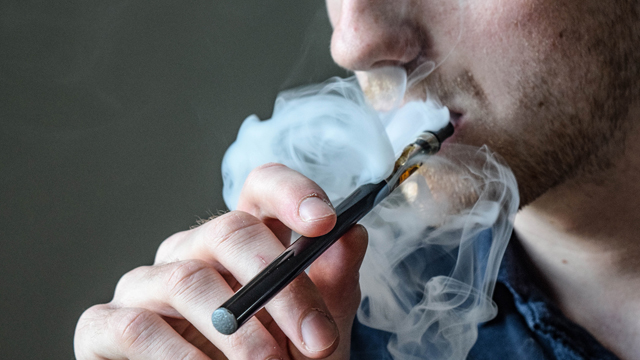Vaping Becoming a Teenage Health Risk
By Michael Jessen, The BC Lung Association
The JUUL has invaded the school.
A wildly popular vaping device, the JUUL has become the go-to e-cigarette for school-age young people.
This despite the claim on the JUUL manufacturer’s Canadian website that “JUUL products are intended for adult smokers who want to switch from combustible cigarettes.” Website users must be at least 19 years old to purchase products on JUUL.ca.
Last month Seycove Secondary School in North Vancouver announced it is locking up almost all of its student bathrooms, blaming “a very serious issue” with vaping.
“All public and private kindergarten to Grade 12 schools in B.C. are tobacco and vape-free under the Tobacco and Vapour Products Control Act and Regulation,” reads a provincial-government website.
Yet evidence is mounting that vaping among students is reaching alarming numbers. Data gathered by the Durham Region Health Department from the area around Oshawa, Ontario shows 17 percent of high school students are vaping, equivalent to five students in every class of 30.
University of Waterloo Prof. David Hammond, in a story posted by CBC News, says his latest data on vaping rates among Canadian teens show a substantial increase “similar to the dramatic increase in the U.S. where rates shot up by 80 percent in one year.”
A report issued in January 2018 by the National Academies of Sciences, Engineering, and Medicine in the U.S. found that among youth there is substantial evidence that e-cigarette use increases the risk of transitioning to smoking conventional cigarettes.
In addition, three published longitudinal studies involving a total of 5,562 adolescents and young adults all concluded e-cigarette use among never cigarette smokers significantly increased the probability of subsequent cigarette smoking initiation.
Each young cigarette smoking initiator will lose a dozen or more years of life, on average, if he or she becomes a lifelong nicotine-addicted cigarette smoker.
The National Academies report concluded that while e-cigarettes are less harmful than conventional cigarettes, they are not without health risks.
“E-cigarettes cannot be simply categorized as either beneficial or harmful,” said David Eaton, chair of the committee that wrote the report, and dean and vice provost of the Graduate School of the University of Washington, Seattle.
“In some circumstances, such as their use by non-smoking adolescents and young adults, their adverse effects clearly warrant concern. In other cases, such as when adult smokers use them to quit smoking, they offer an opportunity to reduce smoking-related illness,” he added.
The B.C. government amended the Tobacco Control Act in 2015 by banning e-cigarette use in public areas and prohibiting the display, marketing and sale of e-cigarettes to minors.
Federally, the Tobacco and Vaping Products Act (TVPA) was enacted on May 23, 2018, to regulate the manufacture, sale, labelling and promotion of tobacco products and nicotine vaping products sold in Canada.
One of the specified purposes of the TVPA is to protect young persons and non-tobacco users from inducements to use vaping products. But almost all vaping devices dispense nicotine, the same ingredient in cigarettes and other tobacco products that produces feelings of stimulation and relaxation.
“The primary incentive to cigarette smoking is the immediate salutary effect of inhaled smoke upon body function,” Philip Morris scientist William Dunn, wrote in a confidential memo in 1972.
He went on to state that “No one has ever become a cigarette smoker by smoking cigarettes without nicotine.”
In his memo, Dunn said the cigarette is merely the package and that the product is nicotine.
Nicotine is a heavily addictive chemical that can be as difficult to give up as heroin. The side effects of nicotine can affect the heart, hormones, and gastrointestinal system while some studies suggest that nicotine may improve memory and concentration.
Nicotine, whether delivered through vapourizers or tobacco binds to receptors in multiple regions of the brain, raising dopamine levels and mimicking a key neurotransmitter that affects focus and arousal.
E-cigarettes differ from traditional cigarettes in that they do not involve the inhalation of materials that are burned with fire. An e-cigarette heats a liquid inside the device to a high temperature and that vapour is then inhaled by the user.
The JUUL is popular with youth due to its unique slim design, an intelligent heating mechanism that creates an aerosol, its recharge abilityvia a USB port, and its JUULpod cartridges with flavours like Virginia tobacco, mint, mango, fruit, vanilla, and cucumber.
Last month, JUUL’s California-based maker stopped selling mango, fruit, and cucumber flavoured pods in the U.S.after Food and Drug Administration Commissioner Scott Gottlieb expressed concerns that flavours play an important role in driving youth appeal.
JUUL will continue to sell those flavours in Canada, however, saying in a statement “we don’t believe that a one-size-fits-all approach to the Canadian and U.S. markets is appropriate.”
The statement added: “We certainly don’t want youth using the product.”
The Canadian Paediatric Society has called for a ban on flavoured e-cigarettes after the U.S. FDA sounded the alarm on a rise in teen vaping, describing it as an “epidemic.”
A financial analyst predicts the 2018 market for vaping devicesin the U.S. alone will be worth $5.5 billion. The analyst said JUUL has 60% of that market share.
To JUUL (yes it is now a verb) is to inhale the nicotine high while avoiding some of the negative characteristics of smoking cigarettes like the tar, the carbon monoxide, the garbage mouth, and the smell.
An e-liquid in the JUULpods contains nicotine salts found in the tobacco leaf, rather than free-base nicotine used in most other e-cigarettes and vapourizers. All the JUUL flavours except cucumber are available with either 5% or 3% nicotine strength.
The JUUL website carries this warning: “This product contains nicotine. Nicotine is an addictive substance. Use of nicotine during pregnancy may harm the fetus.”
The National Academies report uncovered “substantial evidence” that nicotine exposure from e-cigarettes “among experienced adult e-cigarette users can be comparable to that from combustible tobacco cigarettes.”
It also found there is substantial evidence that “heart rate increases after nicotine intake from e-cigarettes,” and that “some chemicals present in e-cigarette aerosols (e.g., formaldehyde, acrolein) are capable of causing DNA damage and mutagenesis.”
Nicotine also makes the pancreas produce less insulin, causing a slight increase in blood sugar or glucose.
Cigarettes, cigars, and smokeless tobacco products contain nicotine in combination with about 600 other ingredients that when burned produce 7,000 different chemicals. Of those chemicals, at least 69 can cause cancer.
Smoking is responsible for about 45,000 deaths in Canada annually and costs the economy over $16 billion in direct and indirect expenses such as health care, fire damage, tobacco control and law enforcement activities, and lost production.
Just in case you are wondering, the National Academies report found there is conclusive evidence that e-cigarette use increases airborne concentrations of particulate matter and nicotine in indoor environments compared with background levels.
Seycove Secondary sent out a note when it announced the closing of student washrooms.
It read: “Vaping poses significant and immediate health risks for all those who do it. The bottom line is that vaping is having a significant negative impact on our community and our learning environment and it is illegal for all of the students in this building for a reason.”
Just when teenage smoking rates were falling to all-time lows, it appears teenagers are succumbing to the same marketing tactics and deceptions that lured earlier generations of cigarette smokers.
Quite simply, choosing to become a lifelong customer of vapourizers is neither a good idea nor worth the health risk.
Michael Jessen is the Nelson area volunteer director for the BC Lung Association, a non-profit and volunteer-based health charity that gratefully accepts public donations.
REFERENCES
1. Cherng ST, Tam J, Christine PJ, Meza R. Modeling the Effects of E-Cigarettes on Smoking Behavior: Implications for Future Adult Smoking Prevalence. Epidemiol. 2016;28:xxx. [PMC free article][PubMed]
2. Leventhal AM, Strong DR, Kirkpatrick MG, et al. Association of electronic cigarette use with initiation of combustible tobacco product smoking in early adolescence. JAMA. 2015;314(7):700–707. [PMC free article][PubMed]
3. Primack BA, Soneji S, Stoolmiller M, Fine MJ, Sargent JD. Progression to traditional cigarette smoking after electronic cigarette use among US adolescents and young adults. JAMA Pediatr. 2015 Sep;:1–7. [PMC free article][PubMed]
4. Wills TA, Knight R, Sargent JD, Gibbons FX, Pagano I, Williams RJ. Longitudinal study of e-cigarette use and onset of cigarette smoking among high school students in Hawaii. Tob Control. 2016 Jan; tobaccocontrol-2015-052705. [PMC free article][PubMed]
5. Jha P, Ramasundarahettige C, Landsman V, et al. 21st-Century Hazards of Smoking and Benefits of Cessation in the United States. N Engl J Med. 2013;368(4):341–350. [PubMed]
Online Tobacco Marketing and Subsequent Tobacco Use http://pediatrics.aappublications.org/content/141/2/e20172927.full
Progression to Traditional Cigarette Smoking After Electronic Cigarette Use Among US Adolescents and Young Adults https://jamanetwork.com/journals/jamapediatrics/fullarticle/2436539
Photo Credit: Vaping360

























